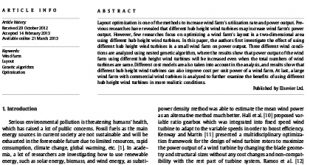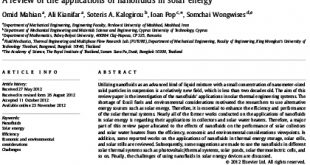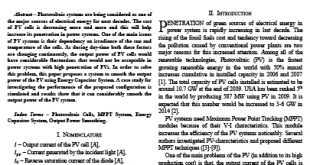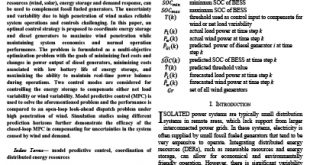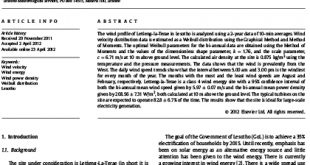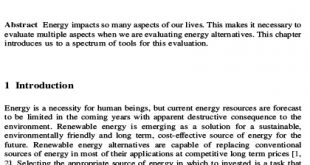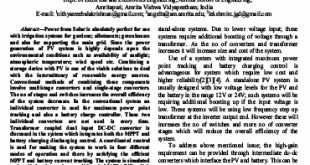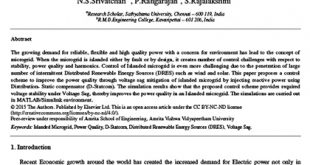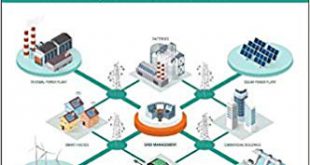In this paper. the authors first investigate the effects of using different hub height wind turbines in a small onshore wind farm with nested GA. The GA parameters are first validated through pretest and comparison with previous research results. Three case studies are conducte d by comparing wind farms using …
Read More »A review of the applications of nanofluids in solar energy
Nanofluids are advanced fluids containing nano-sized particles that have emerged during the last two decades. Nanofluids are used to improve system performance in many thermal engineering systems. This paper presented a review of the applications of nano- fluids in solar thermal engineering. The experimental and numerical studies for solar collectors …
Read More »PV Output Power Smoothing Using Energy Capacitor System
Because of the dependency of output power of the PV cells to the irradiance and temperature. noticeable amount of fluctuations is injected to the system that is not acceptable and should be reduced so that the power quality of the system is improved. In this paper application of the ECS …
Read More »Optimal Control of Distributed Energy Resources using Model Predictive Control
An optimal MPC-based control strategy is proposed for coordinating different DERs for an isolated power system. The designed MPC control strategy is able to meet all the performance objectives which are to minimize fuel costs and changes in power output of diesel generators (minimizing mechanical wear and tear). minimize costs …
Read More »Velocity and power density analysis of the wind at Letseng-la-terae in Lesotho
The analysis shows that Let seng is a Class 4 site with 95% C.I. of both the bi-annual mean wind speed given by 5.97 0.07 m s and the bi-annual mean power density of 208.56 7.31 W m2 both calculated at 10 m a.g.l. The minimum speed is hardly ever …
Read More »Multi-Criteria Applications in Renewable Energy Analysis. a Literature Review
In general. evaluating energy systems is a complex analysis that can be defined as a multi-dimensional space of different indicators and objectives. The use of multicriteria decision analysis (MCDA) techniques provides a reliable methodology to rank alternative renewable energy resources. technologies and projects in the presence of different objectives and …
Read More »PV-Battery System for Smart Green Building using Transformer Coupled DC-DC Converter
Among the RES (renewable energy sources) available in the world PV based energy harvesting are more reliable for rural. off grid and also for green energy applications. Since the electrical energy available from PV is DC we can use it for serving the DC loads which reduces the conversion losses. …
Read More »Control Scheme for Power Quality Improvement in Islanded Microgrid operation
The simulation results shows that proposed control scheme provides required voltage stability in an islanded microgrid and thereby improves power quality at the consumer terminal. Different test conditions have been identified and simulated under islanded microgrid to analyse the effectiveness of D-statcom. The simulation clearly shows that proposed D-statcom can …
Read More »Pathways to a Smarter Power System
Pathways to a Smarter Power System studies different concepts within smart grids that are used in both industry and system regulators (e.g. distribution and transmission system operators) and research. This book covers these concepts from multiple perspectives and in multiple contexts. presenting detailed technical information on renewable energy systems. distributed …
Read More »Medium Voltage Direct Current Grid: Resilient Operation. Control and Protection
Medium Voltage Direct Current Grid is the first comprehensive reference to provide advanced methods and best practices with case studies to Medium Voltage Direct Current Grid (MVDC) for Resilience Operation. Protection and Control. It also provides technical details to tackle emerging challenges. and discuss knowledge and best practices about Modeling and …
Read More » Iran Energy News Oil, Gas, Petrochemical and Energy Field Specialized Channel
Iran Energy News Oil, Gas, Petrochemical and Energy Field Specialized Channel
